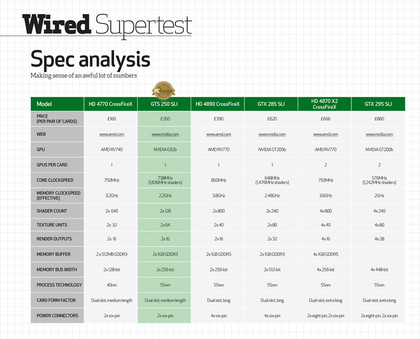6 best Crossfire and SLI graphics cards on test
Multi-GPU set-ups from £160 to £860

BENCHMARKS: As you can see from the performance analysis, multi-GPU has still got a long way to come (click here for full res image)
Spec analysis

SPECIFICATIONS: As you can see the specs of each card are quite similar but offer different levels of performance (click here for full res image)
Verdict
There's nothing quite like a Supertest for weeding out the truth. This time around, the most unmistakable observation must be that there's a limit to how far you should currently go with multi-GPU technology. Not to put too fine a point on it, but both AMD's and Nvidia's quad-GPU installations kind of sucked.
The other major negative we observed was the fact that multi-GPU reliability remains slightly below the level we would like to see. Admittedly, we had relatively few troubles during setup. In fact that part of the process went smoothly save for the GeForce GTS 250 pairing, which took an awful lot of fettling. But in that case, we were using boards from mixed vendors with slightly different clockspeeds, which is never an ideal scenario.
Let it serve as a reminder that if you decide to start mixing and matching, there's no guarantee you'll end up with a working system. Elsewhere, the Radeon HD 4890s refused to run Crysis Warhead in DX10 mode, forcing us to record results in DX9. That was a particularly odd problem given the other AMD pairings ran the DX10 path with no complaints.
Sign up for breaking news, reviews, opinion, top tech deals, and more.
Overall, that may not sound like a lot. But the fact is, when we test single cards we usually have no stability or compatibility issues, period. That's the kind of flawless reliability we demand from multi-GPU technology, before we will give it a totally unreserved thumbs up. But don't go thinking it was all bad. There's plenty of good news.
We're extremely impressed by both the outright performance and the consistency of the GeForce GTX 285s. Money no object, these are the cards we would choose to run in a gaming PC hooked up to a big screen. We wouldn't kick a pair of 4890s out of bed, either. Back in the real world, of course, money is very much an object and for that reason you won't be surprised to hear that our overall winner comes from the most affordable third of our test.
But it's not the Radeon HD 4770s, though they certainly deserve honourable mention. A pair can be had for around £160, usefully cheaper than a single Radeon HD 4890. More importantly, so long as you are running at moderate resolutions, the two 4770s will be the quicker solution. But first prize must go to the trusty o' GeForce GTS 250s. In some ways, that's hardly a surprising result.
After all, they're based on a pretty ancient graphics chipset. But in 1GB trim, that chipset remains uncommonly well optimised for multi-GPU implementations. If you have a 24-inch monitor or perhaps one of the latest full HD 22-inch panels, a pair of 1GB GTS 250s will give you significantly better performance than any single card solution. And, yes, that does indeed include the GeForce GTX 285, and all for £260. 'Nuff said.
Technology and cars. Increasingly the twain shall meet. Which is handy, because Jeremy (Twitter) is addicted to both. Long-time tech journalist, former editor of iCar magazine and incumbent car guru for T3 magazine, Jeremy reckons in-car technology is about to go thermonuclear. No, not exploding cars. That would be silly. And dangerous. But rather an explosive period of unprecedented innovation. Enjoy the ride.